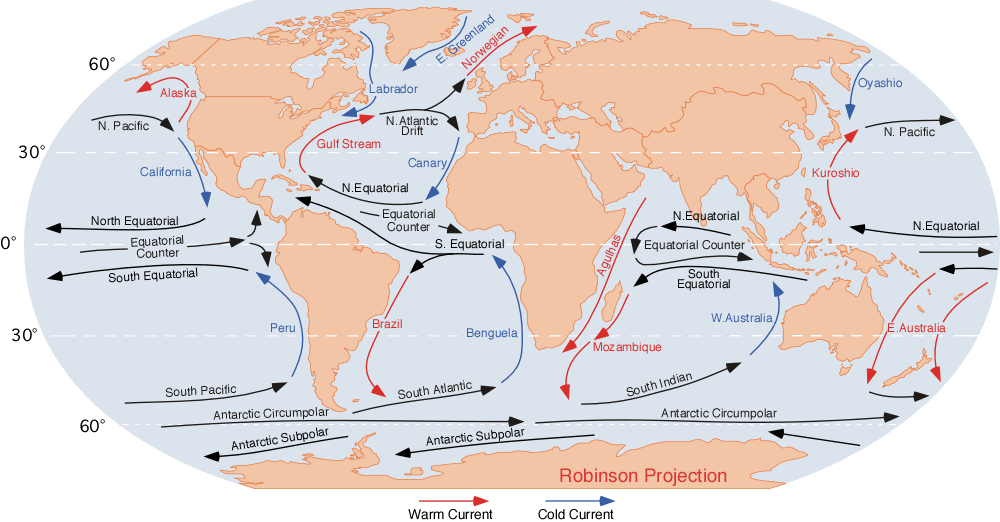
By Dr. Michael Pidwirny (see http://www.physicalgeography.net) - http://blue.utb.edu/paullgj/geog3333/lectures/physgeog.html, [http://skyblue.utb.edu/paullgj/geog3333/lectures/oceancurrents-1.gif
original image], Public Domain, Link
|
When it comes to heat, matter will move from areas of higher heat to areas of lower heat. When you add ice cubes to a warm drink, it might be easy to think of the ice cubes making the drink cooler, but what is actually happening at an energy level is the heat moving to the ice cube, causing it to melt and spread cooler water throughout the drink. This is why the drink also tastes more diluted as the the ice melts. There's just more plain old water in the drink now.
This principle applies to all things, not just your unreasonably warm soda. For ocean water, the area around the Earth's equator is the warmest as it is receives the sun's energy more directly than the rest of the planet's water. This warmer water naturally moves toward cooler water, toward the poles of the Earth. This water also wants to take the most direct path toward the poles. After all, water isn't a thinking organism. |
The Coriolis Effect caused by the Earth's rotation is how currents inherit their circular motion |
Ocean current move clockwise in the northern hemisphere and counter-clockwise in the southern hemisphere |
Gyres: The Ocean's Stream SystemsOkay, so the rules of heat energy transfer coupled with the Earth's rotation make our ocean currents move in circular patterns away from the equator. At least, that'd be the end of the story if not for a third of the planet being a collection of giant landmasses. Our planet's continents play a role in how the currents are directed by way of their coastlines. Ocean currents can't just jump onto land, so they follow the curves of the land instead.
Based on the current formation of the Earth's land, there are 5 major currents across the oceans. These can be found in the north Pacific ocean, south Pacific ocean, north Atlantic ocean, south Atlantic ocean, and the Indian ocean. These currents form massive circular streams covering the entirety of the planet's ocean called gyres, moving warm water to the poles and cool water to the equator. |
The Global Conveyor BeltIf you recall, we mentioned that heat is one of the factors that influence how the currents move, not the only one. The density and salinity of water also play a major role in how water moves. And while these pockets of circular motion do exist thanks to our current continental formation, this water is still doing its best to make it to the north and south poles of the Earth. What happens when water reaches its destination?
When warm water finally reaches a pole, it has cooled a significant amount. When the water approaches freezing, this is when sea ice begins to form. What's interested about sea ice formation is that the salt in the water (remember this is salty ocean water) doesn't get encased in the ice. It's left in the water that didn't freeze. When this happens, the water becomes denser, sinking into the deep sea. |
Western Europe is able to enjoy mild climates at high latitudes all thanks to the north Atlantic gyre, also known as the Gulf Stream System |
The Global Conveyor Belt moves water all around the world. |
This is the global conveyor belt. It's responsible for our functioning water and carbon cycles and influences the local climate of many a coastline around the world (including the coastal desert I initially thought I was going to write about!). It's a massive, complex piece of environmental machinery and a ton of what this planet provides for us in its current form is thanks to it humming along.
A Large But Fragile SystemHowever, bigness doesn't necessarily translate to resilience. As with a number of the systems the Earth provides us, it relies on a careful balance fine tuned over eons of transformation. Going back to the Gulf Stream System for a bit, the reason it comes up so much is that it's noticeably slowing down. Europe is experiencing cooler climates now than it ever has because the warm surfaces waters aren't as steadily making it to their shores.
That would seem to indicate there's something wrong with the north Atlantic gyre, but it's a bit more complicated than that. Due to climbing global temperatures, ice melt has been at a record high near the arctic pole. Without the sea ice pushing the warm surface water to a depth it can travel back toward the equator, the warm surface water has been clogging near the pole, slowing the entire system. |
